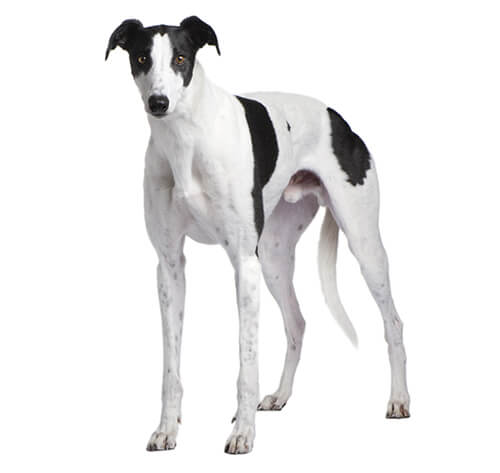
The Greyhound is the fastest breed of dog and also one of the most ancient breeds. In England, this sighthound was used to hunt all types of game, including deer, stag, fox, and hare. The Greyhound is a loving companion that enjoys the company of family and other dogs. He does best with daily exercise, and his short coat is easy to maintain.
DID YOU KNOW? Famous Greyhound owners include President Rutherford B. Hayes and General George A. Custer.
ALSO KNOWN AS: English Greyhound
The need-to-know
- Dog suitable for owners with some experience
- Some training required
- Enjoys active walks
- Enjoys walking an hour a day
- Large dog
- Minimum drool
- Requires grooming once a week
- Non hypoallergenic breed
- Quiet dog
- Not a guard dog
- May require training to live with other pets
- Great family dog
Personality

These dogs are calm and social indoors and can even be rather lazy. They are sensitive dogs who can make ideal family pets if given the right owners! While they are gentle by nature, their natural hunting instinct is always present and owners must be willing to take on the necessary responsibilities that go with the breed. Greyhounds are affectionate with their families, though usually aloof with strangers. They normally get on well with other dogs in the household but cat owners should exercise extreme caution.
History and Origins

Greyhounds were among the most favoured of all dogs; Pharoahs and other Asian and African leaders had images of their dogs engraved into their tombs, dating back to 4,000BC. They were used for coursing antelopes, wolves and deer, and became extremely popular, spreading through the Near East and Europe, eventually arriving in Britain where they became a status symbol, so much so that in 1016 only the elite were allowed to own a Greyhound dog breed. They were used in coursing hares, and later track racing took over, which again proved them to be the fastest dogs on earth: only the cheetah can beat them for speed in the animal world!
Nutrition and Feeding

Large breed dogs, as well as having large appetites, benefit from a different balance of nutrients including minerals and vitamins compared to smaller-breed dogs. Greyhounds are prone to bloating and stomach problems; smaller, more frequent meals can help minimise this risk.
Exercise

Although Greyhounds are the most athletic of all domestic dogs, they do not need copious amounts of exercise. Two 20-minute runs a day will usually suffice. They are known as the 40mph couch potatoes – needing a good, fast sprint, not miles of walking. A reliable recall is essential before they are let off the lead in public areas because of their chase instinct and they may need to be muzzled to protect the small animal population. Note: a warm coat may be needed in cold weather.
Other Information

Health and Common Issues
The Greyhound is generally a relatively healthy breed with few widely recognise health problems.
Grooming Greyhound
One of the easiest breeds to look after with regard to their coats, the short, fine coat needs just an occasional brush over.
Best Family Dog Breeds
While many dogs are traditionally thought of as being good with children, all dogs and children need to be taught to get on with and respect each other, and be safe together. Even so, dogs and young children should never be left alone together and adults should supervise all interactions between them.